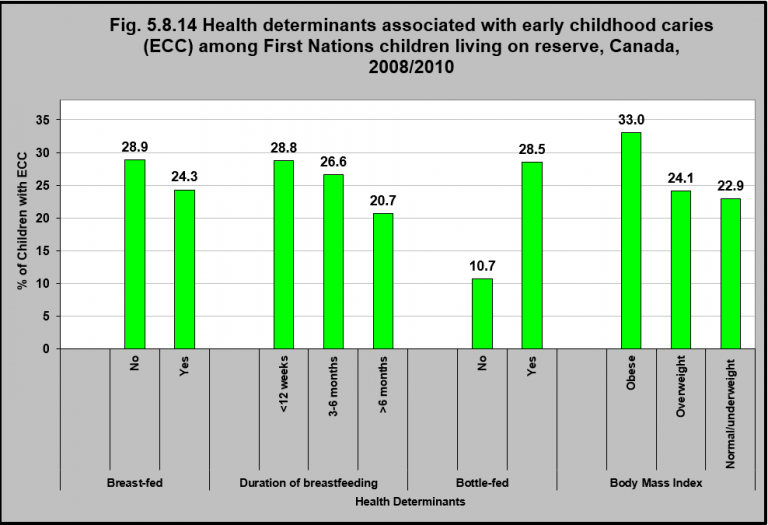Health determinants associated with early childhood caries (ECC) among First Nations children living on reserve, Canada, 2008/2010

Notes:
Breastfeeding was associated with a decrease in the prevalence of ECC, albeit the result was not statistically significant.
Not crowded [≤ 1 person/room]; Crowded [> 1 person/room].
Source: CICH graphic created using data adapted from the First Nations Regional Longitudinal Health Survey (RHS) 2008/10, National report on adults, youth and children living in First Nations Communities. https://fnigc.ca/sites/default/files/docs/first_nations_regional_health_survey_rhs_2008-10_-_national_report.pdf -accessed July 27, 2017.
Twenty-five percent of First Nations children in First Nations communities who were breastfed had early childhood caries*, compared with 29% of those who were bottle fed.
Those children who were breastfed for 6 months or more were less likely to have early childhood caries than were those who were breastfeed for less than 6 months.
Twenty-nine percent of children who were bottle fed had early childhood caries compared with 11% of those who were not bottle fed.
One-third of children who were obese had early childhood caries compared with 24% of those who were overweight and 23% of those who were a normal weight or underweight.
For more information please see the Early childhood tooth decay factsheet developed by the National Collaborating Centre on Aboriginal Health and the Canadian Paediatric Society’s Position Statement on Early Childhood Caries in Indigenous Communities.
*Early childhood caries (ECC) is defined as the presence of tooth decay involving any primary tooth in a child younger than six years of age.1 ECC is also referred to as early childhood tooth decay in the vernacular (and formerly called baby bottle tooth decay).2
1American Academy of Pediatric Dentistry. Definition of early childhood caries (ECC). Pediatr Dent 2005;27(7 Reference Manual):13. http://www.aapd.org/media/policies_guidelines/p_eccclassifications.pdf-accessed July 27, 2017.
2Position Statement – Early Childhood caries in Indigenous communities. 2016. Canadian Paediatric Society. JD Irvine, S Holve, D Krol, R Schroth; Canadian Paediatric Society, First Nations, Inuit and Métis Health Committee. http://www.cps.ca/en/documents/position/oral-health-indigenous-communities-accessed August 5, 2017.
Implications
Tooth decay is more prevalent in bottle-fed babies compared to breastfed babies. This is because breastmilk does not pool in a baby’s mouth like bottled milk, as milk does not flow unless a baby is actively sucking, and if the baby is actively sucking, he/she is also swallowing.3 Further, children breastfed for longer durations have a reduced risk of caries compared to those breastfed for shorter durations. However, nocturnal breastfeeding aimed at comforting infants or children so they can fall asleep prolongs exposure of breast milk against the surfaces of the teeth and increases the risk of dental caries.4
3Bonyatta, K. (n.d.). Is breastfeeding linked to tooth decay. KellyMom.com. https://kellymom.com/ages/older-infant/tooth-decay/ -accessed October 11, 2017.
4Tham, R., Bowatte, G., Dharmage, S.C., Tan, D.M., Lau, M.X.Z., Dai, X., Allen, K.J., & Lodge, C.L. (2015). Breastfeeding and the risk of dental caries: A systematic review and meta-analysis. Acta Paediatrica, 104(S467), 62-84.
